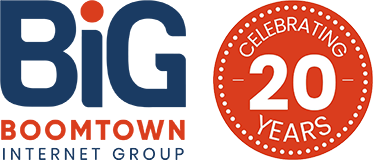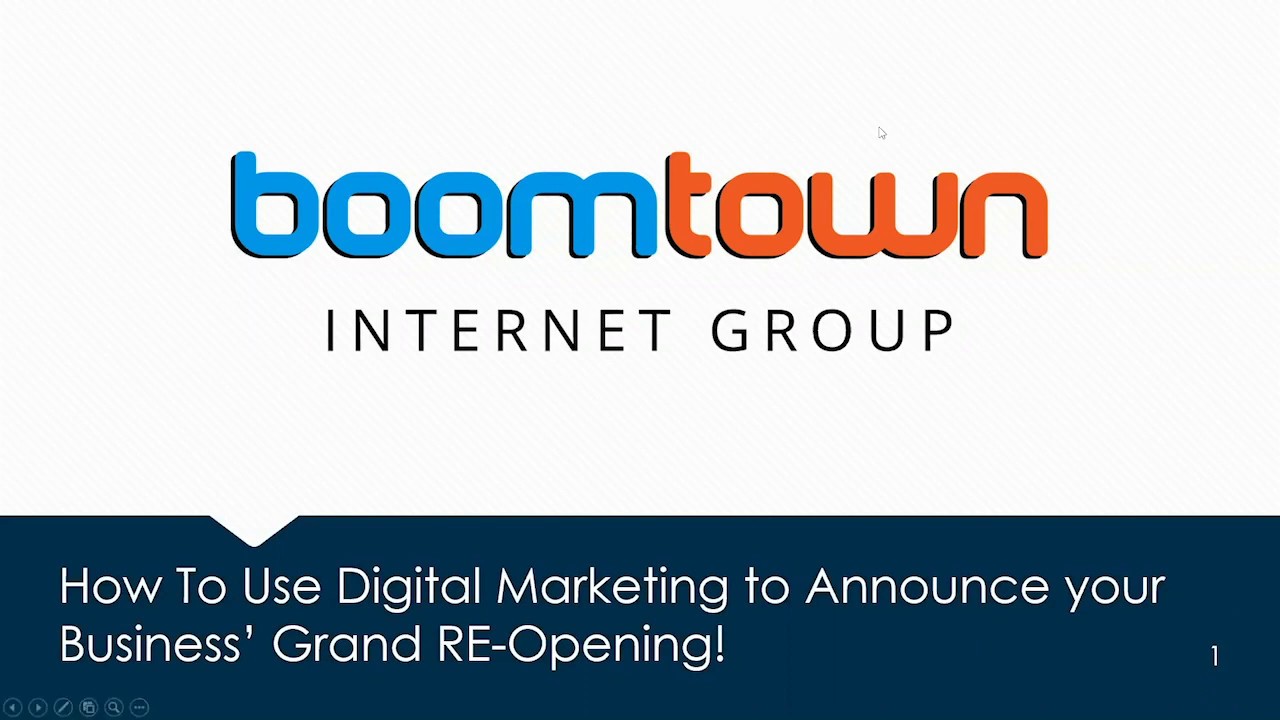In this webinar (given on April 29th, 2020 during the COVID-19 Shutdown) our Marketing Director, Devon McCrossin MBA discusses how to use several aspects of digital marketing to announce a business’ grand re-opening and invite visitors to return for your services and products.
The following is a loose transcript of the video presentation, without the final question and answer session. It contains the following topics:
- How to Improve Visibility to Reach your Current and Potential Customers
- How to Improve Communication and Protect your Current Customer Base
- How to Improve Operations and Transition to a Virtual Marketplace
Watch the full recording of the webinar on YouTube.
The business landscape has changed fundamentally; tomorrow’s environment will be different, but no less rich in possibilities for those who are prepared. – Mckinsey
“24 percent of U.S. consumers do not expect to feel comfortable going back to a shopping mall for at least six months.” – RetailWire
Be Ready to Re-Open. Spread the Word.
It is crucial that your web presence is visible to your customer base before you re-open. Is your brand showing up when customers search for you? Are you active on the right social media platforms? Are you investing in your online visibility and can you measure the results?
There are 3 steps to improve your business’s visibility while re-opening.
- Create an effective online marketing strategy
- Understand how best to effectively use digital platforms
- Optimize your Google Business listing – especially for local businesses.
Create an Effective Online Marketing Strategy for Re-Opening
There are several things to keep in mind when you create a strategy for how you want to reopen your business and define your brand. These include:
- Goals
- Audience Definition
- Brand Voice
- Content
- Tools
Let’s use a car dealership in Pennsylvania which initially was completely closed down when Governor Wolf mandated forced business closings in March of 2020. Local car dealers had to quickly pivot and retool their processes to begin selling cars online as soon as that was made available to them at the end of March. Applying the framework, here is how the PA Car Dealership created an effective online marketing strategy and transition to a virtual car buying process:
- Goals: Transition to a virtual car buying process
- Audience Definition: People interested in new cars
- Brand Voice: Exceptional Customer Service, Community Activists
- Content that was necessary:
- What to expect from the car buying process
- Capture behind the scenes visuals of sanitation precautions
- Offer sales and discounts
- Available DIY Tools to speed up the process included:
- Canva – content creation
- Hootsuite – social post scheduling
- Survey Monkey – capture customer opinions quickly
- MailChimp – email marketing
How to Effectively Use Online Platforms to Announce a Business Re-Opening
Using Social Media to announce your business re-opening should be done thoughtfully. You will need to create content with the dates and details that customers need to know. This can include a series of social posts that you can schedule across platforms. Make this content fun and engaging with a call to action like “come in today” or “shop our new online store!”
There are many ways to creatively use Facebook to announce your business re-opening. Create an event for your Grand Re-opening and invite everyone you know including your business page likes and followers.
Make sure to add plenty of Hashtags. Use popular hashtags, such as #shoplocal, #grandopening, or create your own branded hashtag to create buzz around your business such as #boomtownisopen #boomtownsgrandopening
Social platforms are the perfect way to connect with your customers and listen to what they have to say. Search other social platforms and interact with your potential customers there to better understand their pain points during this time. Then tailor your content to display how you can help.
Email is another crucial tool to have in your business reopening arsenal. Now is a time when you really don’t have to worry about the frequency of your emails. Over-communicate and over-prepare. Some tools to consider if you don’t already have a set email delivery system are MailChimp and Constant Contact.
Content Preparation for Re-Opening a Business
You’ll need to plan and continuously create specific content about your grand re-opening including social distancing changes, changes to store hours, how customers can contact you, sanitation precautions, and more. You can try providing an incentive to share this content with others, and you can use surveys to ask your customers what they need right now. We have found using LinkedIn Lists for B2B emails can be helpful.
Often it is necessary to write a Press Release and pay to have it published on PRweb to create guaranteed traffic to your site and reach a larger audience. In your release, you can mention an incentive to come back such as an in-person discount, special giveaway, or contest announcement.
Another way to really take advantage of content marketing during your reopening process is to try some cross-promotion with your partners or other related businesses in order to publish content on each other’s blog and social media. To do this, come up with a joint strategy that focuses on writing relevant and shareable topics for your blog and partner’s blogs. Then if possible add posts for relevant news sites.
How to Utilize Digital Advertising Platforms During your Re-Opening
Depending on your needs an advertising platform will provide you with instant visibility but you will be charged per click or impression. Some companies like Google and Bing are offering $150 credit or other incentives (grants from Google allow for free ads depending on your spend before the pandemic). You can run ads that display search results, promote local listings, or focus on retargeting visitors to your site who did not complete a goal. Facebook, the most popular social media site has a very visual focus on their ads, and you can highly target them. Here you’ll pay for impressions. If your business is B2B you may consider advertising on LinkedIn and possibly trying their Inmail advertising feature. Regardless of the platform you choose, your reopening ads should target a specific geographical area, describe how your business is now open and provide information on incentives for your services or products. Your ad language should remain strategic and specific, and avoid ambulance-chasing type gimmicks that platforms may not use.
Every Business (Open or Closed) Should Optimize its Google Listing
Use your Google My Business to announce your business reopening. You can also provide promotional offers and post these here as well. You can set up different offers for new customers or those who are returning. Post plenty of photos and videos to show customers what they can expect when they visit. There have been many changes over the past few months to Google Listing Policies, so it is important to check back with Google often. These are some of the features around the pandemic that are currently present on Google My Business:
- The ability to update the business name to indicate open/closed status
- Reviews are available now and can be responded to
- Temporary closures can be announced
- Schema for COVID/coronavirus info is now available
- COVID/coronavirus posts will remain visible longer
- Q&A removed but coming back
- New listings will be delayed (due to Google layoffs)
- Not processing rejected posts for spam reviews
- Edits will remain pending
Communication – Protecting your Current Customer Base
This includes communicating changes to your business and adding Information about the COVID shutdown procedures to your website. Customers and employees alike will want to understand how to stay safe while shopping.
- Over-communicate to your customers
- Over prepare customers for the “new normal”
- Use any means that is most effective for your customer base, such as Email blasts, Social posts, landing pages, blog posts, video, texts, etc.
- Make sure signs and directions at your store location are highly visible with new information
- Employees should be dedicated to keeping physical distancing in place
- Create a document outlining the suggested “new normal” practice for in-person shopping
Retail Stores are Starting to Reopen
“24 percent of U.S. consumers do not expect to feel comfortable going back to a shopping mall for at least six months. Another 26 percent were not sure when they would feel comfortable, or offered no opinion.” – RetailWire
“Even when stores do open again, consumers may not be eager to go into physical locations.” – Retaildive.com
“Customers and associates alike will want to see clear guidelines on staying safe while shopping.” – Retaildive.com
Without a vaccine or understanding of how many people are immune due to a lack of testing, social distancing will likely remain.
Social Distancing in a retail environment includes:
- Configuration of store traffic
- Greeter with specific instructions at the storefront. For instance, you may require customers to wear masks while shopping in accordance with CDC recommendations.
- One-way traffic patterns are gaining acceptance to maintain six-foot distance in aisles
- Use of floor markers and direction from associates
- Limiting the number of customers who can be in a store at one time – Stores should allow no more than five customers for each 1,000 square feet at a time, roughly 20% of a store’s capacity.
- Create social distancing awareness with signage or strips of tape or stickers on the floor directing shoppers where to stand/how to funnel to the cashiers
- Plexiglass barriers for cashiers
- Retailers and shoppers alike may adopt protective gear
- Clean counters more frequently. Offer plenty of hand sanitizer for customers. Perform daily or even hourly deep cleans
- Demand for options like contactless payments and curbside pick up will remain high.
Add a Resource Page About COVID-19 to your Website
Across a range of industries, COVID-19 affects your audience (no matter what your business is) and it’s important to update visitors on what adjustments you’re making as a result of the rapidly changing world we’re living in. – NewMediaCampaignblog
Options for Covid-19 Content on your site
- Add a link in your main navigation bar -Keep it short, for example, “Covid-19”
- Add an alert bar that sits above the navigation – Having a sitewide alert bar is a great way to draw attention
- Add a pop-up with information about Covid-19 \
Have a primary landing page for all your COVID-19 content so that visitors can bookmark and easily find this page. Use the COVID-19 page to:
- Announce Limited hours due to pandemic
- Promote a special deal
- Announce An upcoming event
- Update Your Homepage Masthead – “Your homepage represents the most important information on your site and by pushing information about how COVID-19 impacts your audience, you’re indicating to visitors that you understand the seriousness of the pandemic.”
Content for COVID-19 pages
For most sites, their COVID-19 content is a combination of
- Facts
- Policies
- “Human” content
- #StayHomeSaveLives
- We’ll get through this together, etc
Announce your intentions
- We’ve created this page to bring you the latest updates and resources..
- To keep customers informed during this global pandemic…
- This page serves as your online information center for COVID-19 resources for our community..
- Include links to Federal Legislation and Regulations, such as
- CARES Act overview
Add Links to State Legislation and Regulations which Could Include:
- State shutdown recommendations and important dates
- Lists of essential and nonessential businesses
- External links for information about Covid-19
- Pointing people to reliable sources of information is especially important during a crisis.
- WHO Advice for the Public: World Health Organization advice about COVID-19
- Prevention and Treatment of Coronavirus Disease (CDC): United States Centers for Disease Control guidance for COVID-19
- Johns Hopkins COVID-19 Resource Center: Resource to help the understanding of the virus, inform the public, and brief policymakers.
- Local health department links.
FAQ Pages for COVID-19 should also be created. These should include: answers about how your business is conducting business differently/what your business is doing to ensure the safety of customers,such as contact-less options, curbside pick up procedures, front porch drop off, store cleaning procedures, spacing policies in the store, and limits on number of customers permitted at a time.
Operations: Transitioning to a Virtual Marketplace (3 Steps)
Transaction volumes [from online shopping] in most retail sectors saw a 74% increase in March, compared to the same period last year.” ACI Worldwide, an electronic payments processing company.
Step 1: Use eCommerce to Accept Online Payments
- Set up online payments or eCommerce functionality.
- Add an option to pay using PayPal to your website – PayPal CEO Dan Schulman says coronavirus is giving his business “a tremendous surge. We’re not going to go backwards to what was.” comScore & FORTUNE
- Form a subscription service – More than 22% of companies have seen subscriber acquisition rates grow and educational paid subscriptions have surged 24.1%. ZDNet & Wall Street Journal
Step 2: Implement Online Scheduling and Virtual Meeting Tools
Virtual meeting tools are those such as Zoom*, Skype, Join.me, GoToMeeting*
Scheduling tools for appointments include (but are not limited to):
- Notarize: https://www.notarize.com/
- Appointlet: https://zapier.com/blog/best-appointment-scheduling-apps/
- Acuity Scheduling (Android, iOS, Web)
- Appointlet (Web)
- Gigabook (Android, iOS, Web)
- ScheduleOnce (Web)
- Setmore (Android, iOS, macOS, Web, Windows)
- SimplyBook (Web)
- Square Appointments (iOS, Web)
- SuperSaas (Web)
- vCita (Android, iOS, Web)
Step 3: Pivot the Workforce, Staff, Contractors, and Management to Fill Voids When Needed.
For example, CEOs are packing boxes to get orders delivered on-time and in full while maintaining a safe environment for employees, and call centers are taking on the workload of a traditional receptionist to handle the increase in call volume from Covid-19 questions. Physical distance changes the way managers can oversee their direct reports requiring them to use new functionalities within project management tools.
If you would like help setting up your digital marketing business reopening strategy, Boomtown Internet Group is here to help. We have been working closely with our current clients as they reopen, managing their digital footprint, and reach. Give us a call or email us to tell us about your specific needs at (888) 454-3330 or info@boomtownig.com.



